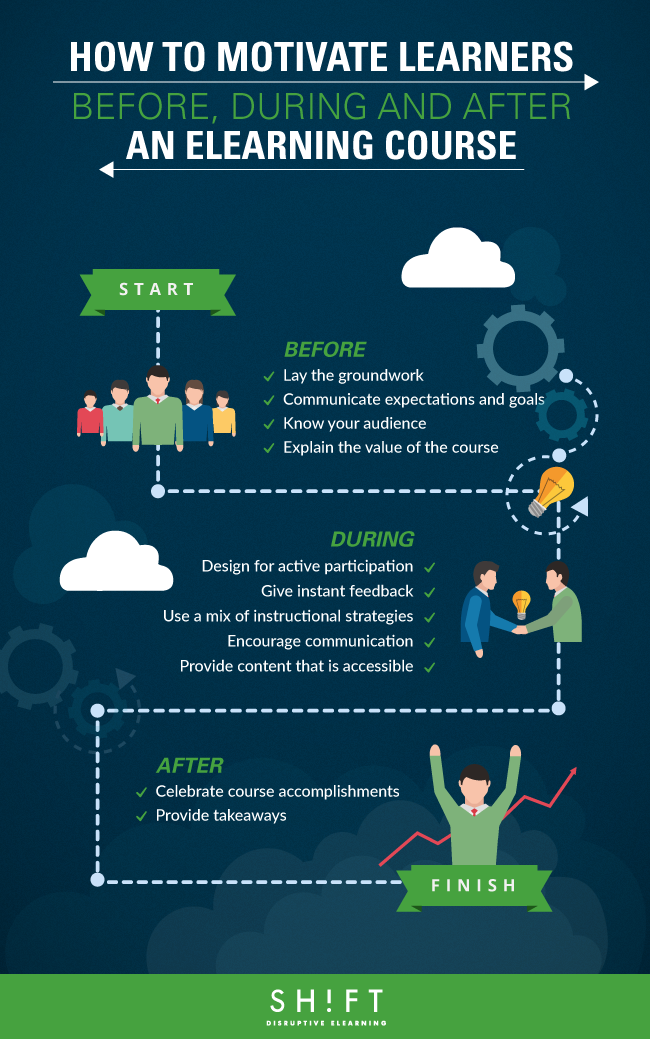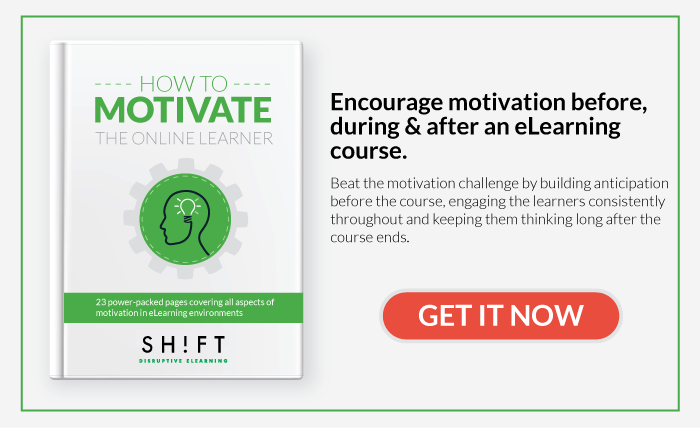Keeping learners motivated throughout an eLearning course is a challenge for even the most seasoned designers. Not only is it difficult to hook and keep learners engaged offline, but asynchronous training invites an even larger set of challenges. There is no way to read visual cues if students are bored or for an instructor to redirect training if there are questions. Online courses also provide an anonymity that prevents some learners from even participating at all.
So, what is the key to motivating learners and ensuring they stay on track throughout a course? The trick is to line the design with elements that promote motivation before, during, and even after course completion. After all, you cannot make someone learn, but you can create an environment that promotes learning.
Here are some suggested ways to maintain learner motivation before, during and even after your eLearning course.

Before the Course
Technique #1: Begin by laying the groundwork and building anticipation for the course.
Figure out a way to hook the learners before they ever begin the course. This can be done via a pre-work activity or a short video introducing the content. By creating anticipation, you are building learner excitement and motivating them before they ever even access the content.
Idea: Give an engaging title to the course. This should create interest as well as grab people’s attention.
Technique #2: Communicate expectations and goals before the course starts.
By sharing with the learners what they can expect, you are already motivating the students to meet standards set forth. Be very clear about how the content will be organized and lay out the expected outcomes. This removes some anxiety and begins to get the learners excited about accomplishing tasks set forth.
There are some ways to do this:
- Provide a written syllabus with expectations and assignments.
- List expectations at the beginning slides of your the course.
- Outline expectations in the course overview online.
Technique #3: Know your audience
Figure out who your learners are and assess their needs before designing the course. If possible, send out a poll to determine items such as what tasks the learners need to complete their job, find out if they are familiar with technical jargon and determine the level of experience for the average learner. A thorough assessment can provide keys to what factors will motivate them. This insight can be factored in to build emotional connections between the learners and the content, further strengthening intrinsic motivation.
Read more: These 27 Questions Will Help You (Really) Know Your Learners
Technique #4: Explain the value of your course beforehand
Let the learners know specific ways that this eLearning course will improve skills related to their work performance. Showing the content relevancy will directly increase learner buy-in. Explain how the course can help them master a specific skill or solve a problem. Link the content to current events and real-world scenarios for them to see the relevance.
During the Course
Technique #1: Design for active participation.
A recent study has found that active learning increases retention, understanding, and pass rates. It also improves learner motivation.
Create activities that encourage exploration. People learn best from experience, and the more authentic and participatory the experience, the greater the learning. Present a common problem and provide the resources for the learners to create their own solutions. Taking control of the learning process provides self-motivation and deeper engagement in the content.
Read more: Learner-Centered Design: The Secret of Creating Engaging eLearning Experiences
Technique #2: Give relevant feedback and progress visualization.
Include quizzes, games or other interactive exercises providing the type of feedback that helps learners track their own progress. Ensure that the feedback is immediate so that the students can use the information in subsequent exercises. Find a way to incorporate a visual that shows advancement, such as a progress meter that fills in as modules are completed. Motivation will increase when success is visual.
Read more: The Power of Feedback
Technique #3: Use a mix of instructional strategies.
Not only does providing variety increases engagement, but certain learners may have success with different strategies based on their personal learning styles. Mix examples, case studies, images and infographics, scenarios, videos, collaboration and games that encourage the learner to be proactive in different ways. Through exposure to varied content, they will remain engaged and, therefore, motivated.
Read more: Use These 5 Instructional Design Strategies to Create an Effective eLearning Course
Technique #4: Encourage communication.
While this can be challenging via eLearning, find ways that students can link to other people taking the same course content such as through social media, blogs or discussion boards. Learning is social, and people are more successful in collaboration than isolation. Sharing ideas and receiving feedback from others keeps the learner motivated to learn.
Technique #5: Break down your content.
Good eLearning design chunks the content in a way that helps people remember what they have learned. Small pieces of information are not only easier to assimilate, but they allow learners to complete activities quickly and in a way that is convenient to them. Chunking helps to create an internal framework for processing information, thus making the learner not only more successful but also more motivated to continue their learning process.
Read more: Numbers Don't Lie: Why Bite-Sized Learning is Better for Your Learners (and You too)
After the Course
Technique #1: Celebrate Course Completion
People remain motivated when they have an awareness of their accomplishments. Not only should you find ways to for the learner to receive feedback throughout the course, but also seek to encourage learning even after the course is completed. Challenge the audience to continue their research or learn to solve even more complex problems. Provide a course certificate or a small prize or recognition for a job well done.
Technique #2: Provide Takeaways
Give the learners something to take back to their jobs with them, such as a job aid, a quote or an infographic. Without any sort of reinforcement, learners may forget up to 90% of the course within a matter of days. Help them remember with something concrete that ties directly back to the content. The more they remember, the more they will be motivated to implement skills learned throughout the course.
Keeping learners motivated is a challenging process, especially with eLearning courses. Beat the motivation challenge by building anticipation before the course, engaging the learners consistently throughout and keeping them thinking long after the course ends. The learners should always be forefront in your mind as you design because their success leads to intrinsic motivation, which leads to the ultimate goal of learning.
Also read: The Basics of Motivational eLearning Design



